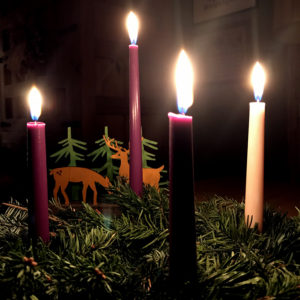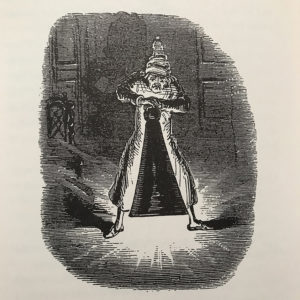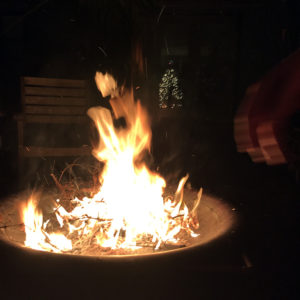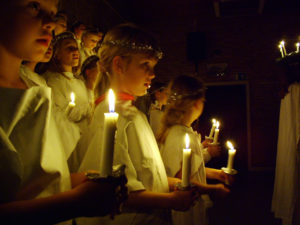One late December morning years ago, over coffee at Minnie’s Diner, Minnie confided to me that she really dislikes when the Fourth Sunday of Advent comes right before Christmas, as it did then and as it does this year. Minnie’s never ready for Christmas, but on those years when the Fourth Sunday of Advent falls days and days before Christmas Day, she feels she’s got more time to prepare. She doesn’t, of course; it just feels like she does. But I can understand this, and I find myself feeling the same way the older I get.
I also find that I love preparing for things like Christmas, and this is what Advent is all about: making our homes as fair as we are able, making our hearts ready for Christmas, bringing more light to the world even as the natural world grows darker. We are just two days past the solstice of Midwinter. Daylight already is increasing, but it will be late March before day and night are balanced again. And so tonight, in the midst of our darkest nights, we get to light all four candles in the circular ring of our Advent wreath. In some traditions, the candles are blue and white, but in ours, the candles are three purple and one rose. Purple, the liturgical color of penitence, and rose, of joy. Each candle has its meaning. The First Sunday’s purple candle is for faith, the Second Sunday’s purple candle, which is lit with the first, is for hope. The rose candle was added last Sunday, which is known as Gaudete Sunday, and it is meant to be more celebratory. And on this, the Fourth Sunday of Advent, we light all four candles, the lighting of the third purple candle for peace. With it, our circle is complete and the room filled with the light of all four candles: Faith and hope and joy and peace. The four candles dispel the night, and their illumination means that Christmas is fast approaching. Hopefully, we have made ourselves ready to appreciate its presence.
And despite Minnie’s protests, Christmas Eve will come tomorrow with the setting sun and then Christmas Day and then, the rest of Christmastide. Each year now for oh, many years, I’ve been writing a daily post for this Book of Days, one for each of the Twelve Days of Christmas that begin on the 26th. We’re going to take a slightly different approach this year, if that’s ok with you. There’s a lot going on here… Christmas cards to make, Christmas cookies to bake, and we’re trying to finish up building Seth’s pottery studio before the year is done. It’s good to have goals. Our house is also a stop on the Lake Worth Cottage Tour this January, and to see it right now you would not believe we would have been asked. There are about a dozen projects in mid-stream that need completing: one more door to be stripped of old paint, sanded and varnished; one more doorframe that needs to be painted. It’s right behind Seth’s seat at the table. He sits there at breakfast and dinner and I sit across from him and he never sees the doorframe that needs painting, but me, I do. I’ve been looking at it for three years now. It just never gets finished. And this is how most of our home projects go. We take them to the point where they are about 98.5% completed, and then move on to something else. Agreeing to take part in the cottage tour was, for me, a chance to finish these things off. But now the pressure’s on, of course, for the tour is just four weeks away… and so you know now what a lot of our Yuletide will be like.
So here’s my compromise to you: I will write about all these upcoming Twelve Days of Christmas––and what lies beyond, for it continues, in some traditions, all the way to Candlemas at the start of February. But instead of a daily post, you’ll get maybe three posts. Think of it in a Dickensian way: You’ll be visited by three spirits. They won’t all come on Christmas Eve, like in A Christmas Carol, but they’ll come in their proper time along our journey through the Twelve Days. And hopefully they, too, will dispel the night. Indeed, by the time Christmas concludes at Candlemas, the natural world will be halfway between solstice and equinox, and daylight will be dramatically increased. Take a step away from commercial Christmas to experience Christmas in this manner, and it becomes infinitely more beautiful. For now, though, on this Fourth Sunday of Advent that brings in the Christmas season, know that I’ll be thinking of you as I’m sanding and painting and doing whatever it is that needs doing all these Yuletide days to come, but I’ll especially be thinking of you when I write. Please accept those three spirits when they come for what they are: my gift to you this Christmastide.
“The End of the First Spirit.” Engraving by John Leech, 1843, for the original publication of A Christmas Carol by Charles Dickens. The Ghost of Christmas Past shows Scrooge more than he cares to see about himself, and as a result, Scrooge snuffs him out with an extinguisher cap. “The Spirit dropped beneath it, so that the extinguisher covered its whole form; but though Scrooge pressed it down with all his force, he could not hide the light: which streamed from under it, in an unbroken flood upon the ground.”



